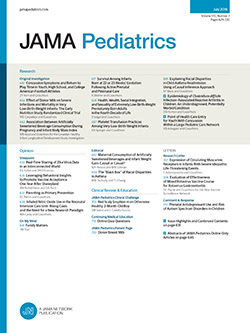Supplemental Donor Milk vs Infant Formula in Moderate to Late Preterm Infants: A Randomized Clinical Trial.
IF 18
1区 医学
Q1 PEDIATRICS
引用次数: 0
Abstract
Importance High-quality evidence supports the use of pasteurized donor human milk (donor milk) in very preterm infants with insufficient maternal milk available. However, evidence to guide the use of donor milk in more mature preterm infants is lacking. Objective To compare the effect of donor milk vs term infant formula, used to supplement insufficient maternal milk, on the time to establish full enteral feeds in moderate to late preterm infants. Design, Setting, and Participants This multisite, blinded randomized clinical trial was conducted from July 6, 2021, to April 5, 2023, at 2 Australian neonatal units. Infants 4 days old or younger, born between 32 + 0 and 36 + 6 weeks' gestation, with a birth weight of 1500 g or higher, and admitted to a neonatal unit were eligible if they were clinically stable, ready to commence or had commenced enteral feeds, and had insufficient maternal milk available. Infants were followed up until 6-month corrected age (CA). Follow-up assessments until 6-month CA were completed by December 4, 2023, and data analyses were completed by January 23, 2025. Intervention Infants were randomly assigned to receive supplemental donor milk or term formula for up to 8 days, stratified by site and gestational age at birth. Main Outcomes and Measures The primary outcome was time to full enteral feeds (defined as 150 mL/kg/day). Secondary outcomes included feed intolerance, growth, body composition, breast milk feeding, and hospital readmissions to 6-month CA. Results Of 201 infants randomized (99 to donor milk, 102 to formula), the mean (SD) birth gestational age was 34.6 (1.2) weeks, mean (SD) birth weight was 2267.1 (450.8) g, 88 infants (43.8%) were female, and 75 infants (37.3%) were a twin or triplet. Mean (SD) time to reach full enteral feeds did not differ between groups (donor milk group: 5.7 [2.6] days; formula group: 5.8 [3.4] days; adjusted mean difference, -0.07; 95% CI, -0.90 to 0.76). Secondary outcomes were similar between groups, except that infants in the donor milk group had a lower rate of birth weight regain compared with the formula group (mean [SD] time to regain in donor milk group: 10.7 [5.7] days; formula group: 8.4 [4.4] days; hazard ratio, 0.65; 95% CI, 0.47-0.88). Conclusions and Relevance In this multisite randomized clinical trial, supplemental donor milk did not reduce time to full enteral feeds in moderate to late preterm infants compared with term formula for up to 8 days. Trial Registration anzctr.org.au Identifier: ACTRN12621000529842.补充供体奶与婴儿配方奶粉对中度至晚期早产儿的影响:一项随机临床试验。
重要性高质量证据支持在母乳不足的极早产儿中使用巴氏消毒的供人乳(供体奶)。然而,缺乏证据来指导在更成熟的早产儿中使用供体母乳。目的比较供乳与足月婴儿配方奶对中、晚期早产儿建立全肠内喂养时间的影响。设计、环境和参与者这项多地点、盲法随机临床试验于2021年7月6日至2023年4月5日在2个澳大利亚新生儿单位进行。出生在妊娠32 + 0至36 + 6周之间、出生体重为1500克或更高、出生在新生儿病房的4天或更小的婴儿,如果临床稳定、准备开始或已经开始肠内喂养,并且母乳不足,则符合条件。婴儿随访至6个月矫正年龄(CA)。到2023年12月4日完成6个月CA的随访评估,到2025年1月23日完成数据分析。干预:根据出生部位和胎龄,婴儿被随机分配接受最多8天的补充供体奶或足月配方奶粉。主要指标和测量方法主要指标是完全肠内喂养的时间(定义为150ml /kg/天)。次要结局包括饲料不耐受、生长、身体组成、母乳喂养和6个月后的再入院情况。结果201名随机婴儿(99名母乳喂养,102名配方奶喂养),平均出生胎龄(SD)为34.6(1.2)周,平均出生体重(SD)为2267.1 (450.8)g, 88名婴儿(43.8%)为女性,75名婴儿(37.3%)为双胞胎或三胞胎。各组达到完全肠内喂养的平均(SD)时间无差异(供乳组:5.7[2.6]天;配方组:5.8[3.4]天;调整后平均差-0.07;95% CI, -0.90 ~ 0.76)。两组间的次要结局相似,除了供奶组婴儿的出生体重恢复率低于配方奶组(供奶组平均[SD]恢复时间:10.7[5.7]天;配方组:8.4[4.4]天;风险比0.65;95% ci, 0.47-0.88)。结论和相关性在这项多地点随机临床试验中,与足月配方奶相比,补充供体奶并没有减少中度至晚期早产儿8天内完全肠内喂养的时间。标识符:ACTRN12621000529842。
本文章由计算机程序翻译,如有差异,请以英文原文为准。
求助全文
约1分钟内获得全文
求助全文
来源期刊

JAMA Pediatrics
PEDIATRICS-
CiteScore
31.60
自引率
1.90%
发文量
357
期刊介绍:
JAMA Pediatrics, the oldest continuously published pediatric journal in the US since 1911, is an international peer-reviewed publication and a part of the JAMA Network. Published weekly online and in 12 issues annually, it garners over 8.4 million article views and downloads yearly. All research articles become freely accessible online after 12 months without any author fees, and through the WHO's HINARI program, the online version is accessible to institutions in developing countries.
With a focus on advancing the health of infants, children, and adolescents, JAMA Pediatrics serves as a platform for discussing crucial issues and policies in child and adolescent health care. Leveraging the latest technology, it ensures timely access to information for its readers worldwide.
 求助内容:
求助内容: 应助结果提醒方式:
应助结果提醒方式:


